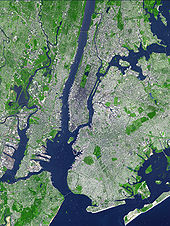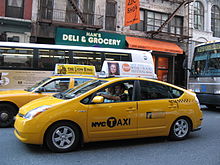New York City is located in the Northeastern United States, in southeastern New York State, approximately halfway between Washington, D.C. and Boston. The location at the mouth of the Hudson River, which feeds into a naturally sheltered harbor and then into the Atlantic Ocean, has helped the city grow in significance as a trading city. Much of New York is built on the three islands of Manhattan, Staten Island, and Long Island, making land scarce and encouraging a high population density.
The Hudson River flows through the Hudson Valley into New York Bay. Between New York City and Troy, New York, the river is an estuary. The Hudson separates the city from New Jersey. The East River – a tidal strait – flows from Long Island Sound and separates the Bronx and Manhattan from Long Island. The Harlem River, another tidal strait between the East and Hudson Rivers, separates Manhattan from the Bronx. The Bronx River, which flows through the Bronx and Westchester County, is the only entirely fresh water river in the city.
The city's land has been altered substantially by human intervention, with considerable land reclamation along the waterfronts since Dutch colonial times. Reclamation is most prominent in Lower Manhattan, with developments such as Battery Park City in the 1970s and 1980s. Some of the natural variations in topography have been evened out, especially in Manhattan.
The city's land area is estimated at 304.8 square miles (789 km2). Its total area is 468.9 square miles (1,214 km2). 164.1 square miles (425 km2) of this are water and 304.8 square miles (789 km2) is land. The highest point in the city is Todt Hill on Staten Island, which, at 409.8 feet (124.9 m) above sea level, is the highest point on the Eastern Seaboard south of Maine. The summit of the ridge is mostly covered in woodlands as part of the Staten Island Greenbelt.
Climate
Under the Köppen climate classification New York City has a humid subtropical climate (Cfa), and using the 0 °C (32 °F) threshold it is the northernmost major city on the continent with such categorization.
The area averages 234 days with at least some sunshine annually, and averages 58% of possible sunshine annually, accumulating 2,400 to 2,800 hours of sunshine per annum.
Winters are cold and damp, and prevailing wind patterns that blow offshore minimize the moderating effects of the Atlantic Ocean. Yet the Atlantic and the partial shielding of the Appalachians keep the city warmer in the winter than inland North American cities located at similar or lesser latitudes such as Pittsburgh, Cincinnati, and Indianapolis. The average temperature in January, the area's coldest month, is 32.1 °F(0.1 °C). However temperatures in winter could for a few days be as low as 10 °F (−12 °C) and as high as 50 °F (10 °C). Spring and autumn are unpredictable, and can range from chilly to warm, although they are usually mild with low humidity. Summers are typically hot and humid with a July average of 76.5 °F (24.7 °C). Nighttime conditions are often exacerbated by the urban heat island phenomenon, and temperatures exceed 90 °F (32 °C) on average of 18 days each summer and can exceed 100 °F (38 °C) every 4–6 years.
The city receives 49.7 inches (1,260 mm) of precipitation annually, which is fairly spread throughout the year. Average winter snowfall for 1971 to 2000 has been 22 inches (56 cm), but this usually varies considerably from year to year. Hurricanes and tropical storms are rare in the New York area, but are not unheard of and always have the potential to strike the area.
Extreme temperatures have ranged from −15 to 106 °F (-26 to 41 °C), recorded on February 9, 1934 and July 9, 1936, respectively.
Environment
Mass transit use in New York City is the highest in the United States, and gasoline consumption in the city is the same rate as the national average in the 1920s. The city's high level of mass transit use saved 1.8 billion gallons of oil in 2006; New York City saves half of all the oil saved by transit nationwide. The city's population density, low automobile use and high transit utility make it among the most energy efficient cities in the United States. Its greenhouse gas emissions are 7.1 metric tons per person compared with the national average of 24.5. New Yorkers are collectively responsible for 1% of the nation's greenhouse gas emissions though they comprise 2.7% of the nation's population. The average New Yorker consumes less than half the electricity used by a resident of San Francisco and nearly one-quarter the electricity consumed by a resident of Dallas.
In recent years, the city has focused on reducing its environmental impact. Large amounts of concentrated pollution in New York has led to a high incidence of asthma and other respiratory conditions among the city's residents. The city government is required to purchase only the most energy-efficient equipment for use in city offices and public housing. New York has the largest clean air diesel-hybrid and compressed natural gas bus fleet in the country, and also, by mid 2010 the city has 3,715hybrid taxis and other clean diesel vehicles, representing around 28% of New York's taxi fleet in service, the most in any city in North America.
The city government was a petitioner in the landmark Massachusetts v. Environmental Protection Agency Supreme Court case forcing the EPA to regulate greenhouse gases as pollutants. The city is also a leader in the construction of energy-efficient green office buildings, including the Hearst Tower among others.
The city is supplied with drinking water by the protected Catskill Mountains watershed. As a result of the watershed's integrity and undisturbed natural water filtration system, New York is one of only four major cities in the United States with drinking water pure enough not to require purification by water treatment plants.
New York is the only US city where autoless households constitute a greater percentage of the population than households with one or more cars. Approximately 55% of all NYC households do not have a car in the household


No comments:
Post a Comment